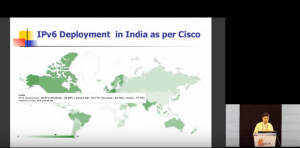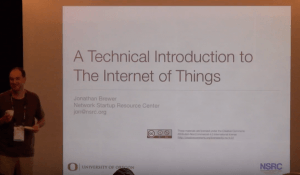
We already covered the IPv6 Deployment session during APRICOT 2017, but there were several other IPv6-related sessions that are worth mentioning.
First thing to mention is that there was a tutorial on deployment of IPv6 in a production mobile network. This was a 1.5-hour session led by Jeff Schmidt (Telstra) and provided some insights into what the business and technical considerations were, and what ended-up actually being deployed on their network.
 Jon Brewer (NSRC) is someone who always managed to conjure up interesting talks at APRICOT Conferences, and his tutorial on the Internet-of-Things was no exception. Whilst IoT is not specifically IPv6, it’s likely that IPv6 will be required to facilitate the plethora of devices expected in future.
Jon Brewer (NSRC) is someone who always managed to conjure up interesting talks at APRICOT Conferences, and his tutorial on the Internet-of-Things was no exception. Whilst IoT is not specifically IPv6, it’s likely that IPv6 will be required to facilitate the plethora of devices expected in future.
This tutorial discussed core concepts and the types of applications that are enabled by IoT technologies, before covering radio and network protocols for low-power WANs such as the 802 series, 3GPP and LoRaWAN. Higher-level protocols used in IoT are also discussed including CoAP, MQTT, REST and Websockets.
- Internet-of-Things Tutorial (YouTube)
On a related note, there was also a presentation by Jeff Apcar (Cisco) on the Low Power Wide Area (LPWA). This covered this new area of communications where networks of sensors with limited power availability need to be connected across both urban and rural areas; some over long range wireless networks with substantial RF interference.
 Last, but not least, there was the IPv6 Readiness Measurement session. This is an initiative of TWNIC (the Taiwan National Internet Registry) aims to encourage organisations working on IPv6 deployment to share their IPv6 measurement methods and results.
Last, but not least, there was the IPv6 Readiness Measurement session. This is an initiative of TWNIC (the Taiwan National Internet Registry) aims to encourage organisations working on IPv6 deployment to share their IPv6 measurement methods and results.
The IPv6 situation in India as presented by Ajai Kumar (NIXI) is becoming interesting, with different measurements calculating IPv6 deployment somewhere between 20 and 40% which makes India the economy with the highest rate of deployment in the Asia-Pacific region. Even more encouragingly, some large organisations including the State Bank of India have even higher rates of deployment, most of the major IXPs are IPv6-enabled, whilst the .in ccTLD also support IPv6.
The Asia-Pacific economy with the second-highest level of IPv6 deployment is Japan, whose situation was presented by Tomohiro Fujisaki (NTT). IPv6 deployment continues to increase and currently sits somewhere just over 20%. However, three major cellular operators have announced they will commence IPv6 services in 2017, whilst a number of fixed-line ISPs have already started to offer commercial ISP services. Some government services are now available via IPv6, although support by the major Japanese content providers still needs to improve.
 Things are a bit less positive in Korea, Taiwan and Vietnam, although there was substantial progress with IPv6 deployment in Vietnam during 2016, with FPT Telecom becoming the first ISP in the country to offer IPv6 to customers. The Taiwanese government has also deployed IPv6 in most of its agencies, has started to offer IPv6 on its public Wi-Fi service (iTaiwan), whilst around 20% of the traffic of TANet (the NREN) is using IPv6.
Things are a bit less positive in Korea, Taiwan and Vietnam, although there was substantial progress with IPv6 deployment in Vietnam during 2016, with FPT Telecom becoming the first ISP in the country to offer IPv6 to customers. The Taiwanese government has also deployed IPv6 in most of its agencies, has started to offer IPv6 on its public Wi-Fi service (iTaiwan), whilst around 20% of the traffic of TANet (the NREN) is using IPv6.
One of the reasons for limited IPv6 uptake in Korea appears because it has one of the highest user bases in the world, and therefore obtained a large amount of IPv4 resources early on. IPv6 deployment only really started 3 years ago, and then mostly on cellular networks, so that combined with the lack of local content available via IPv6 has provided limited incentives for ISPs to provide this to their customers.
However, regardless of where you are, we encourage you to consider deploying IPv6, so please check our Start Here page for more information!
